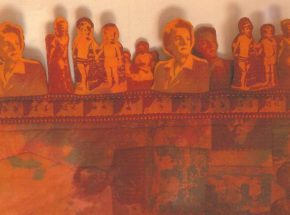

Wenda von Weise was born in Princeton, New Jersey. She grew up sewing, taught by her mother, a watercolorist. In 1959, she enrolled in classes at the Cincinnati Museum of Art, where she had studied the textile and tapestry collection donated by the von Weise family. In the early 1960s the family moved to Gates Mills, Ohio, outsdide Cleveland, where she began a lifelong project of photographing and documenting the landscape around her. “I first started putting photographs on fabric using the photo-silkscreening process, and printing the colors using dye,” she recalled. In 1969, she enrolled in the fibers program at the Cleveland Institute of Art, majoring in textile design with a minor in photography. She completed her studies in 1975. Although she had extensive sewing experience, von Weise was drawn to making quilts for aesthetic reasons: “The idea of the family photograph album and its history; the idea of a family’s quilt and how so many quilts were prized and tereasured and kept away. I wanted to combine both of them, so I learned the photographic techniques I needed to know [in order to] transfer the photographic images to the fabric and to quilt them.” She borrowed all the old family photos and worked through an entire series of quilts (including the one in thie exhibition) until, as she put it, “I had said what I wanted to say.” Her studies with Robert Rauschenberg in the early 1970s greatly influenced her work, as he had been a pioneer in the use of photo transfers in printmaking, and in the use of combine images that integrated photography. During the short period until her death, she established herself as a major contributor to contemporary art quilting as a recognized art form in the United States.
Gayle A. Pritchard, “Uncommon Threads: Ohio’s Quilt Revolution.” Athens, Ohio: 2006.
